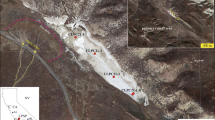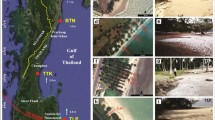Abstract
During the last low stand of sea level, rivers and streams drained across the present northwestern Gulf of Mexico continental shelf depositing sediments in several shallow-water deltas near the present shelf-slope boundary. The weight of these wedges of prograded sediments triggered or augmented both subsidence of local depositional basins and upward movement of diapiric material around the basin edges. A depositional basin off the southwestern Louisiana coast records migration of the basinal axis during late Pleistocene and Holocene time indicating relative growth of diapirs along the basin margin throughout the most recent geological record.
Similar content being viewed by others
References
Pyle, C. A., Berryhill, H. L., Jr., and Trippet, A. R., 1979. Maps showing late Pleistocene and Holocene evolution of the South Texas Continental Shelf. U.S. Geol. Survey Misc. Field Studies Map, MF-1134, 2 sheets.
Lehner, P., 1969. Salt tectonics and Pleistocene stratigraphy on continental slope of northern Gulf of Mexico. Am. Assoc. Petroleum Geologists Bull. v. 53, p. 2431–2479.
Humphris, C. C., Jr., 1978. Salt movement on continental slope, northern Gulf of Mexico. In: A. H. Bouma, G. T. Moore and J. M. Coleman (eds.), Framework, Facies, and Oil-trapping Characteristics of the Upper Continental Margin. Am. Assoc. Petroleum Geologists. Studies in Geology No. 7, p. 69–85.
McGookey, D. P., 1975. Gulf Coast Cenozoic sediments and structure— An excellent example of extra-continental sedimentation. Gulf Coast Assoc. Geol. Socs. Trans., v. 25, p. 104–120.
Wilhelm, O. and Ewing, M., 1972. Geology and history of the Gulf of Mexico. Geol. Soc. America Bull, v. 83, p. 575–600.
Ewing, M., and Antoine, J., 1966. New seismic data concerning sediments and diapiric structures in Sigsbee Deep and upper continental slope, Gulf of Mexico. Am. Assoc. Petroleum Geologists Bull., v. 50, no. 3, p. 479–504.
Woodbury, H. O., and others, 1973. Pliocene and Pleistocene depocenters, outer continental shelf, Louisiana and Texas. Am. Assoc. Petroleum Geologists Bull., v. 57, p. 2428–2439.
Stuart, C. H., and Caughey, C. A., 1977. Seismic facies and sedimentology of terrigenous Pleistocene deposits in northeast and central Gulf of Mexico. In: C. E. Payton (ed.), Seismic Stratigraphy Applications to Hydrocarbon Exploration. Am. Assoc. Petroleum Geologists Memoir 26, p. 249–275.
Sidner, B. R., and Poag, C. W., 1973. Foraminiferal evidence of late Quanternary sea level fluctuations from the west Flower Garden Bank. Texas A&M Univ., Report TAMU-SG-73-213, 124p.
Trippet, A. R., 1980. Geology of East and West Flower Garden Banks, northwest Gulf of Mexico. U.s. Geol. Survey Misc. Field Studies Map MF-1232.
Poag, C. W., 1972. Shelf-edge submarine banks in the Gulf of Mexico— paleocology and biostratigraphy. Gulf Coast Assoc. Geol. Socs. Trans., v. 22, p. 267–281.
Author information
Authors and Affiliations
Rights and permissions
About this article
Cite this article
Trippet, A.R. Interaction between diapirism and sediment loading at the shelf-slope boundary, northwest Gulf of Mexico. Geo-Marine Letters 1, 111–114 (1981). https://doi.org/10.1007/BF02463327
Received:
Revised:
Issue Date:
DOI: https://doi.org/10.1007/BF02463327




